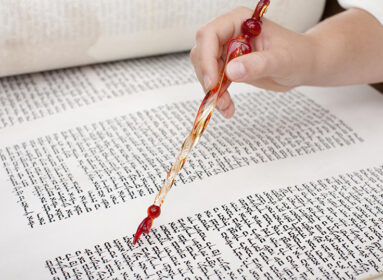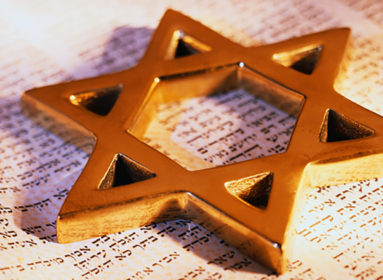
Benjamin Franklin, Moses and the Great Seal of the United States
By Louis Arthur Norton
Judaism almost became a central theme in an important symbol of the United States of America.
It all started when John Adams, Benjamin Franklin, Thomas Jefferson, Robert R. Livingston, and Roger Sherman were appointed as a committee to draft an official declaration of independence for the American colonies to be sent to the King of England. The committee met from June 11 to its adoption on July 4 and publication on July 5.
An entry for July 4, 1776 in the Journals of Continental Congress reads: “Resolved, That Dr. Franklin, Mr. J. Adams and Mr. Jefferson, be a committee, to bring in a device for a seal for the United States of America.” These three distinguished statesmen were now assigned the task of submitting themes that would eventually become the Great Seal of the United States of America. They were among the most capable intellectuals in the new nation but they had little knowledge of heraldry. Therefore Swiss immigrant and artist Pierre Eugène Du Simitière was appointed as the committee’s consultant for the proper design of a heraldic national seal.
The men consulted among themselves between July 4 and August 13, then each presented their design suggestions to their congressional colleagues. These colonies, which had declared themselves nascent states, were rebelling against oppression. They were attempting to free themselves from the yoke of economic and political slavery and establish a new beginning in a “Promised Land” across a body of water. Franklin, although not particularly religious, envisioned an allegorical scene depicting biblical history placed on one side of the seal. He envisioned a Mosaic scene from Exodus, people confronted by a tyrant in their struggle for freedom, just as a sovereign and his regime had subjugated the 13 American colonies: “And Moses stretched out his hand over the sea; and Jehovah caused the sea to go back by a strong east wind all the night, and made the sea dry land, and the waters were divided. And the children of Israel went into the midst of the sea upon the dry ground: and the waters were a wall unto them on their right hand, and on their left” (Exodus 14:21-22).
 Franklin described the tableau as follows: “Moses standing on the Shore, and extending his Hand over the Sea, thereby causing the same to overwhelm Pharaoh who is sitting in an open Chariot, a Crown on his Head and a Sword in his Hand. Rays from a Pillar of Fire in the Clouds reaching to Moses, to express that he acts by Command of the Deity. Motto, Rebellion to Tyrants is Obedience to God.”
Franklin described the tableau as follows: “Moses standing on the Shore, and extending his Hand over the Sea, thereby causing the same to overwhelm Pharaoh who is sitting in an open Chariot, a Crown on his Head and a Sword in his Hand. Rays from a Pillar of Fire in the Clouds reaching to Moses, to express that he acts by Command of the Deity. Motto, Rebellion to Tyrants is Obedience to God.”
Franklin’s design was recommended for the reverse side of the Great Seal, but there is no record of Du Simitière making a sketch of the design. Illustrator Benson J. Lossing made the drawing that appeared in Harper’s New Monthly Magazine in July 1856, but chose to omit Franklin’s “Rays from a Pillar of Fire in the Clouds reaching to Moses.”
Thomas Jefferson also suggested a Torah-inspired theme depicting the children of Israel in the wilderness, led by a cloud by day and a pillar of fire by night. The original Franklin and Jefferson designs were rejected, perhaps being thought too aggressive. Other proposals depicting Greek and Roman mythology also were disapproved. After many other drafts and revisions, the now familiar bald eagle with arrows in its left talon and an olive branch in its right pincer emerged as the winner.
But one inadvertent reference to Judaism was incorporated. Above the eagle’s head are thirteen stars in a blue field arranged in rows of 1-4-3-4-1. They form a stylized or graphic six-pointed Star of David.
Exodus 14:30-31 summarizes the moral that the Israelites learned that day: “When the Israelites saw the great power of the Lord displayed against the Egyptians, the people feared the Lord and put their trust in him…” Perhaps that led to the motto “In God we trust” found on American currency.
The emancipation of the Jewish people is celebrated at Passover, but it is also the celebration of a new year – a renewal. Therefore this was an appropriate comparison on another level: a bridging of the Torah with the formation of the United States.
In summary, the first proposal for the Great Seal of the United States had a very Jewish context. Intellectually and historically it was a perceptive metaphor.
Louis Arthur Norton, professor emeritus at the University of Connecticut, has written extensively about maritime history topics, as well as Jewish-themed articles. He is author of the Jewish short story fiction, A Rabbi, a Chicken and a Marriage, that appeared in OffCourse: a Literary Journal, published by State University of New York at Albany. He is a resident of West Simsbury.








 Southern New England Jewish Ledger
Southern New England Jewish Ledger










